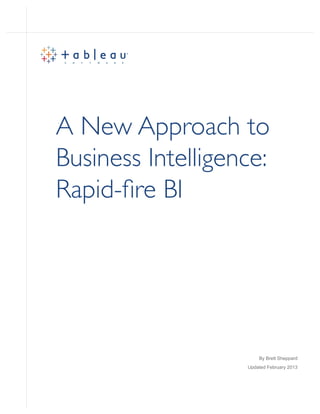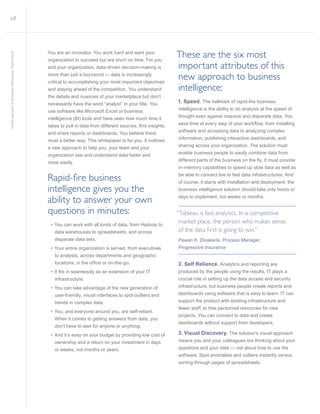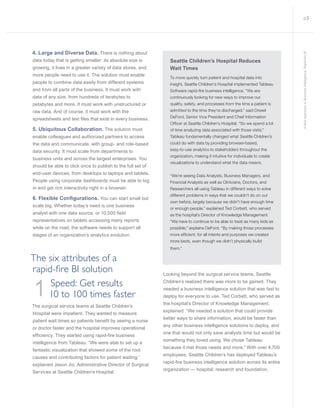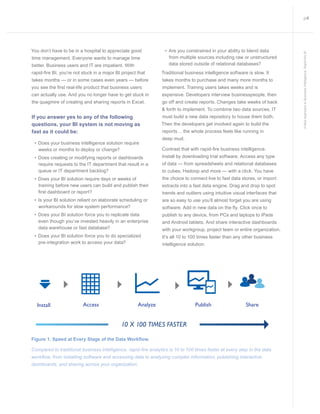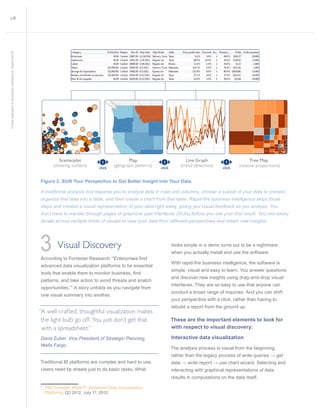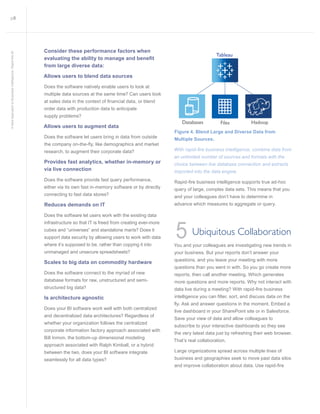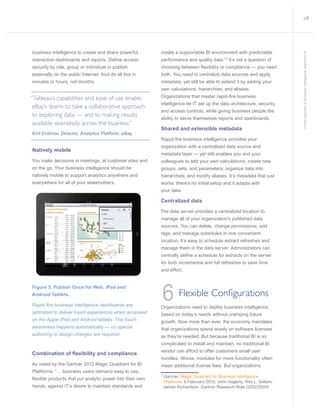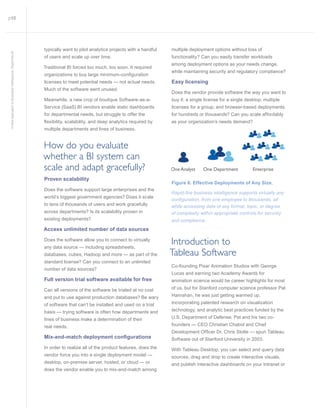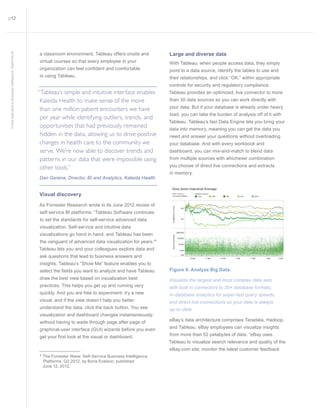Rapid-fire BI
- 1. A New Approach to Business Intelligence: Rapid-fire BI By Brett Sheppard Updated February 2013
- 2. p2 ANewApproachtoBusinessIntelligence:Rapid-fireBI You are an innovator. You work hard and want your organization to succeed but are short on time. For you and your organization, data-driven decision-making is more than just a buzzword — data is increasingly critical to accomplishing your most important objectives and staying ahead of the competition. You understand the details and nuances of your marketplace but don’t necessarily have the word “analyst” in your title. You use software like Microsoft Excel or business intelligence (BI) tools and have seen how much time it ta es to pull in data ro di erent sources find insights and share reports or dashboards. You believe there must a better way. This whitepaper is for you. It outlines a new approach to help you, your team and your organization see and understand data faster and more easily. Rapid-fire business intelligence gives you the ability to answer your own questions in minutes: • You can work with all kinds of data, from Hadoop to data warehouses to spreadsheets, and across disparate data sets. • Your entire organization is served, from executives to analysts, across departments and geographic locations in the o fice or on-the-go It fits in sea lessl as an e tension o our I infrastructure. • You can take advantage of the new generation of user-friendly, visual interfaces to spot outliers and trends in complex data. • You, and everyone around you, are self-reliant. When it comes to getting answers from data, you don’t have to wait for anyone or anything. • And it’s easy on your budget by providing low cost of ownership and a return on your investment in days or weeks, not months or years. These are the six most important attributes of this new approach to business intelligence: 1. Speed. he hall ar o rapid-fire usiness intelligence is the ability to do analysis at the speed of thought even against massive and disparate data. You sa e ti e at e er step o our wor ow ro installing software and accessing data to analyzing complex information, publishing interactive dashboards, and sharing across your organization. The solution must enable business people to easily combine data from di erent parts o the usiness on the It ust pro ide in-memory capabilities to speed up slow data as well as be able to connect live to fast data infrastructures. And of course, it starts with installation and deployment: the business intelligence solution should take only hours or days to implement, not weeks or months. “Tableau is fast analytics. In a competitive market place, the person who makes sense of the data first is going to win.” Pawan K. Divakarla, Process Manager, Progressive Insurance 2. Self Reliance. Analytics and reporting are produced by the people using the results. IT plays a crucial role in setting up the data access and security infrastructure, but business people create reports and dashboards using software that is easy to learn. IT can support the product with existing infrastructure and fewer staff, to free personnel resources for new projects. You can connect to data and create dashboards without support from developers. 3. Visual Discovery. The solution’s visual approach means you and your colleagues are thinking about your questions and your data — not about how to use the software. Spot anomalies and outliers instantly versus sorting through pages of spreadsheets.
- 3. p3 ANewApproachtoBusinessIntelligence:Rapid-fireBI 4. Large and Diverse Data. There is nothing about data today that is getting smaller: its absolute size is growing, it lives in a greater variety of data stores, and more people need to use it. The solution must enable people to combine data easily from different systems and from all parts of the business. It must work with data of any size, from hundreds of terabytes to petabytes and more. It must work with unstructured or raw data. And of course, it must work with the spreadsheets and te t files that e ist in e er usiness 5. Ubiquitous Collaboration. The solution must enable colleagues and authorized partners to access the data and communicate, with group- and role-based data security. It must scale from departments to business units and across the largest enterprises. You should be able to click once to publish to the full set of end-user devices, from desktops to laptops and tablets. People using corporate dashboards must be able to log in and get rich interactivity right in a browser. 6. Flexible Configurations. You can start small but scale big. Whether today’s need is one business anal st with one data source or field representatives on tablets accessing many reports while on the road, the software needs to support all stages of an organization’s analytics evolution. The six attributes of a rapid-fire BI solution 1 Speed: Get results 10 to 100 times faster The surgical service teams at Seattle Children’s Hospital were impatient. They wanted to measure patient wait ti es so patients enefit seeing a nurse or doctor faster and the hospital improves operational e ficienc he started using rapid-fire usiness intelligence from Tableau. “We were able to set up a fantastic visualization that showed some of the root causes and contributing factors for patient waiting,” explained Jason Jio, Administrative Director of Surgical Services at Seattle Children’s Hospital. Looking beyond the surgical service teams, Seattle Children’s realized there was more to be gained. They needed a business intelligence solution that was fast to deploy for everyone to use. Ted Corbett, who served as the hospital’s Director of Knowledge Management, explained: “We needed a solution that could provide better ways to share information, would be faster than any other business intelligence solutions to deploy, and one that would not only save analysts time but would be something they loved using. We chose Tableau because it met those needs and more.” With over 4,700 employees, Seattle Children’s has deployed Tableau’s rapid-fire usiness intelligence solution across its entire organization — hospital, research and foundation. Seattle Children’s Hospital Reduces Wait Times To more quickly turn patient and hospital data into insight, Seattle Children’s Hospital implemented Tableau Software rapid-fire business intelligence. “We are continuously looking for new ways to improve our quality, safety, and processes from the time a patient is admitted to the time they’re discharged,” said Drexel DeFord, Senior Vice President and Chief Information Officer at Seattle Children’s Hospital. “So we spend a lot of time analyzing data associated with those visits.” Tableau fundamentally changed what Seattle Children’s could do with data by providing browser-based, easy-to-use analytics to stakeholders throughout the organization, making it intuitive for individuals to create visualizations to understand what the data means. “We’re seeing Data Analysts, Business Managers, and Financial Analysts as well as Clinicians, Doctors, and Researchers all using Tableau in different ways to solve different problems in ways that we couldn’t do on our own before, largely because we didn’t have enough time or enough people,” explained Ted Corbett, who served as the hospital’s Director of Knowledge Management. “We have to continue to be able to treat as many kids as possible,” explains DeFord. “By making those processes more efficient, for all intents and purposes we created more beds, even though we didn’t physically build them.”
- 4. p4 ANewApproachtoBusinessIntelligence:Rapid-fireBI You don’t have to be in a hospital to appreciate good time management. Everyone wants to manage time better. Business users and IT are impatient. With rapid-fire BI ou re not stuc in a a or BI pro ect that takes months — or in some cases even years — before ou see the first real-li e product that usiness users can actually use. And you no longer have to get stuck in the quagmire of creating and sharing reports in Excel. If you answer yes to any of the following questions, your BI system is not moving as fast as it could be: • Does your business intelligence solution require weeks or months to deploy or change? • Does creating or modifying reports or dashboards require requests to the IT department that result in a queue or IT department backlog? • Does your BI solution require days or weeks of training before new users can build and publish their first dash oard or report • Is your BI solution reliant on elaborate scheduling or workarounds for slow system performance? • Does your BI solution force you to replicate data even though you’ve invested heavily in an enterprise data warehouse or fast database? • Does your BI solution force you to do specialized pre-integration work to access your data? • Are you constrained in your ability to blend data from multiple sources including raw or unstructured data stored outside of relational databases? Traditional business intelligence software is slow. It takes months to purchase and many more months to implement. Training users takes weeks and is expensive. Developers interview businesspeople, then go off and create reports. Changes take weeks of back & forth to implement. To combine two data sources, IT must build a new data repository to house them both. Then the developers get involved again to build the reports… the whole process feels like running in deep mud. ontrast that with rapid-fire usiness intelligence Install by downloading trial software. Access any type of data — from spreadsheets and relational databases to cubes, Hadoop and more — with a click. You have the choice to connect live to fast data stores, or import extracts into a fast data engine. Drag and drop to spot trends and outliers using intuitive visual interfaces that are so easy to use you’ll almost forget you are using so tware Add in new data on the lic once to publish to any device, from PCs and laptops to iPads and Android tablets. And share interactive dashboards with your workgroup, project team or entire organization. It’s all 10 to 100 times faster than any other business intelligence solution. Figure 1. Speed at Every Stage of the Data Workflow. Compared to traditional business intelligence, rapid-fire analytics is 10 to 100 times faster at every step in the data workflow, from installing software and accessing data to analyzing complex information, publishing interactive dashboards, and sharing across your organization. Install Access Analyze Publish Share 10 X 100 TIMES FASTER
- 5. p5 ANewApproachtoBusinessIntelligence:Rapid-fireBI ith rapid-fire usiness intelligence e plorator analytics and reporting that used to take hours may take only minutes. For Blastrac Manufacturing CIO Dan Murray: “Before, we were spending four to six man-hours a week producing basic reports. Now it takes us ten minutes. And the quality of the report is much better, much more visible and interactive.” 2 Self Reliance Self-reliant BI provides business users with a way to answer questions about the business and adapt to change. It requires few resources from IT to install or maintain. IT sets up the data architecture, security, and access controls. Business people serve themselves reports and dashboards with data of any size or format within the controls established by IT. Traditional business intelligence has been a chore for IT: from installation, deployment, and programming to report writing, change requests, support, and maintenance. This doesn’t even include the costly professional services that are required. Even more troublesome, when business units require new functionality, traditional BI often “breaks.” This causes organizations to upgrade late or not at all, reducing the ability to adopt advances in technology. And when you do upgrade, it’s a massive project involving many resources and risks. But the real problem is that the people who have to make decisions, even everyday decisions, cannot independently and directly ask the questions they need answered when needed. They are typically dependent on an undersized group of BI developers who have their own schedules to keep. So, what are the elements to look for with respect to self-reliant BI? Look for a system that: • Allows anyone to easily build dashboards and reports from disparate data sources and make odifications on-the- powers in or ed s eptics who find actiona le insights from the combination of their business experience and analytics. • Provides built-in best practices to support effective analysis and save time. • pens des top data such as te t files and Microsoft Excel, without having to reformat that data. • Connects to all major databases with a few clicks. • Enables easy sharing through web and mobile dashboards, SharePoint, or visuals exported to PowerPoint or email. • Provides interactive functionality on the web such as drill-down and filtering • Provides role- and group-based security for secure publishing. • Allows users to connect to the existing data architecture. • Enforces the security and controls set up by IT. Cornell University Delivers Ten Times the Analyses in Half the Time Cornell University struggled to enable its users with capabilities to produce and manage their own dashboards for tracking of key performance indicators (KPIs). A project using a traditional BI platform ran for nine months with no results and no adoption. Cornell’s data IT administration team brought in Tableau and immediately users were accessing and using the dashboards, and creating their own dashboards in collaboration with the IT team. When the Cornell team began using Tableau, they estimated a 50- to 75-percent reduction in report development time, and now several years later, it is clear that the savings are in the 75- to 90-percent range. Said Cindy Sedlacek, director of data administration and reporting for the College of Arts and Sciences at Cornell University: “The savings have been so significant that it has allowed the team to focus on deploying data and metrics in additional functional areas much sooner than anticipated. Switching to Tableau enabled the KPI team to reduce its FTEs (full-time equivalents) from 5.5 to 2.5 and to deliver 10 times as many analyses in half the time.”
- 6. p6 ANewApproachtoBusinessIntelligence:Rapid-fireBI 3 Visual Discovery According to orrester Research: nterprises find advanced data visualization platforms to be essential tools that ena le the to onitor usiness find patterns, and take action to avoid threats and snatch opportunities.”1 A story unfolds as you navigate from one visual summary into another. “A well-crafted, thoughtful visualization makes the light bulb go off. You just don’t get that with a spreadsheet.” Dana Zuber, Vice President of Strategic Planning, Wells Fargo Traditional BI platforms are complex and hard to use. Users need tip sheets just to do basic tasks. What 1 The Forrester Wave™: Advanced Data Visualization Platforms, Q3 2012, July 17, 2012. looks simple in a demo turns out to be a nightmare when you actually install and use the software. ith rapid-fire usiness intelligence the so tware is simple, visual and easy to learn. You answer questions and discover new insights using drag-and-drop visual interfaces. They are so easy to use that anyone can conduct a broad range of inquiries. And you can shift your perspective with a click, rather than having to rebuild a report from the ground up. These are the important elements to look for with respect to visual discovery: Interactive data visualization The analysis process is visual from the beginning, rather than the legac process o write ueries get data write report use chart wi ard electing and interacting with graphical representations of data results in computations on the data itself. Scatterplot (showing outliers) Map (geograpic patterns) Line Graph (trend detection) Tree Map (relative proportions) About Tableau maps: www.tableausoftware.com/mapdata Figure 2. Shift Your Perspective to Get Better Insight into Your Data. A traditional analysis tool requires you to analyze data in rows and columns, choose a subset of your data to present, organize that data into a table, and then create a chart from that table. Rapid-fire business intelligence skips those steps and creates a visual representation of your data right away, giving you visual feedback as you analyze. You don’t have to wander through pages of graphical user interfaces (GUIs) before you see your first result. You can easily iterate across multiple kinds of visuals to view your data from different perspectives and obtain new insights. click 1 click 1 click 1
- 7. p7 ANewApproachtoBusinessIntelligence:Rapid-fireBI Easy-to-use visual user interfaces Does the software have an easy-to-understand user inter ace defined in usiness ter s and not argon o users regard the software as easy-to-use and intuitive? New users are often the best judge of effective user interfaces. Can anyone answer a broad range of inquiries with simple drag and drop? Geographic intelligence Geographic analysis is critical. Is mapping easy to use and co plete re uiring no specialt ap files plug-ins fees or third party tools? Drill down and drill through Can you drill through to the underlying detail in just a few clicks? Is drill-down / drill-through an automatic occurrence requiring no special scripting or advance set-up? Users should be able to select data graphically and drill to the detailed underlying data at all times. Built-in best practices Does the software support good information visualization by design? Does it provide meaningful color schemes and view types that promote understanding of data? Figure 3. Intuitive BI Software. Fast, easy-to-use visual interfaces mean you are thinking about your questions and your data — not about how to use the software. 4 Large and Diverse Data Traditional business intelligence made the assumption that all important data can be moved into a consolidated enterprise architecture. But that’s not the reality for most organizations, which have different databases in different places, which are short on time and staff, and whose needs change constantly. Here are some questions to consider about your existing BI platform: • Does your BI platform require you to choose between a live database connection or import into an in-database analytics engine, instead of allowing you to combine these approaches based on performance and project requirements? • Does IT have to combine disparate data into a single location before business users can begin analyzing it? • Do users regularly cut and paste data from expensive data warehouses into spreadsheets so they can use all the data they need to understand the business? • Do you get limited value from large data because your people don’t have tools that can analyze it? • It is di ficult or slow or our BI plat or to connect to newer database technologies like Hadoop? If you answered yes to one or more of these questions, ou a want to consider a aster and ore e i le alternative. Rapid fire usiness intelligence lets ou lend di erent relational, semi-structured and raw data sources in real time, without expensive up-front integration costs. That means that users don’t need to know the details of how data is stored to ask and answer questions. Whether your data is in a spreadsheet, a database, a data warehouse open source file s ste s li e adoop or all of those, users can quickly connect to the data they need and consolidate it.
- 8. p8 ANewApproachtoBusinessIntelligence:Rapid-fireBI Consider these performance factors when evaluating the ability to manage and benefit from large diverse data: Allows users to blend data sources Does the software natively enable users to look at multiple data sources at the same time? Can users look at sales data in the conte t o financial data or lend order data with production data to anticipate supply problems? Allows users to augment data Does the software let users bring in data from outside the co pan on-the- li e de ographics and ar et research, to augment their corporate data? Provides fast analytics, whether in-memory or via live connection Does the software provide fast query performance, either via its own fast in-memory software or by directly connecting to fast data stores? Reduces demands on IT Does the software let users work with the existing data infrastructure so that IT is freed from creating ever-more cubes and “universes” and standalone marts? Does it support data security by allowing users to work with data where it’s supposed to be, rather than copying it into unmanaged and unsecure spreadsheets? Scales to big data on commodity hardware Does the software connect to the myriad of new database formats for raw, unstructured and semi- structured big data? Is architecture agnostic Does your BI software work well with both centralized and decentralized data architectures? Regardless of whether your organization follows the centralized corporate information factory approach associated with Bill Inmon, the bottom-up dimensional modeling approach associated with Ralph Kimball, or a hybrid between the two, does your BI software integrate seamlessly for all data types? Hadoop Tableau Databases Files Figure 4. Blend Large and Diverse Data from Multiple Sources. With rapid-fire business intelligence, combine data from an unlimited number of sources and formats with the choice between live database connection and extracts imported into the data engine. Rapid-fire usiness intelligence supports true ad-hoc query of large, complex data sets. This means that you and your colleagues don’t have to determine in advance which measures to aggregate or query. 5 Ubiquitous Collaboration You and your colleagues are investigating new trends in your business. But your reports don’t answer your questions, and you leave your meeting with more questions than you went in with. So you go create more reports, then call another meeting. Which generates more questions and more reports. Why not interact with data li e during a eeting ith rapid-fire usiness intelligence ou can filter sort and discuss data on the As and answer uestions in the o ent ed a live dashboard in your SharePoint site or in Salesforce. Save your view of data and allow colleagues to subscribe to your interactive dashboards so they see the very latest data just by refreshing their web browser. That’s real collaboration. Large organizations spread across multiple lines of business and geographies seek to move past data silos and i pro e colla oration a out data se rapid-fire
- 9. p9 ANewApproachtoBusinessIntelligence:Rapid-fireBI business intelligence to create and share powerful, interacti e dash oards and reports efine access security by role, group or individual or publish externally on the public Internet. And do all this in minutes or hours, not months. “Tableau’s capabilities and ease of use enable eBay’s teams to take a collaborative approach to exploring data — and to making results available seamlessly across the business.” Kiril Evtimov, Director, Analytics Platform, eBay Natively mobile You make decisions in meetings, at customer sites and on the go. Your business intelligence should be natively mobile to support analytics anywhere and everywhere for all of your stakeholders. Figure 5. Publish Once for Web, iPad and Android Tablets. Rapid-fire business intelligence dashboards are optimized to deliver touch experiences when accessed on the Apple iPad and Android tablets. This touch awareness happens automatically — no special authoring or design changes are required. Combination of flexibility and compliance As noted by the Gartner 2012 Magic Quadrant for BI Platforms: “… business users demand easy to use, e i le products that put anal tic power into their own hands, against IT’s desire to maintain standards and create a supportable BI environment with predictable performance and quality data.”2 It’s not a question of choosing etween e i ilit or co pliance ou need both. You need to centralize data sources and apply metadata, yet still be able to extend it by adding your own calculations, hierarchies, and aliases. rgani ations that aster rapid-fire usiness intelligence let IT set up the data architecture, security, and access controls, while giving business people the ability to serve themselves reports and dashboards. Shared and extensible metadata Rapid-fire usiness intelligence pro ides our organization with a centralized data source and metadata layer — yet still enables you and your colleagues to add your own calculations; create new groups, sets, and parameters; organize data into hierarchies; and modify aliases. It’s metadata that just works: there’s no initial setup and it adapts with your data. Centralized data The data server provides a centralized location to manage all of your organization’s published data sources. You can delete, change permissions, add tags, and manage schedules in one convenient location. It’s easy to schedule extract refreshes and manage them in the data server. Administrators can centrall define a schedule or e tracts on the ser er for both incremental and full refreshes to save time and effort. 6 Flexible Configurations Organizations need to deploy business intelligence based on today’s needs without cramping future growth. Now more than ever, the economy mandates that organizations spend wisely on software licenses as they’re needed. But because traditional BI is so complicated to install and maintain, no traditional BI vendor can afford to offer customers small user bundles. Worse, modules for more functionality often mean additional license fees. But organizations 2 Gartner, Magic Quadrant for Business Intelligence Platforms, 6 February 2012, John Hagerty, Rita L. Sallam, James Richardson, Gartner Research Note G00225500
- 10. p10 ANewApproachtoBusinessIntelligence:Rapid-fireBI typically want to pilot analytics projects with a handful of users and scale up over time. Traditional BI forced too much, too soon. It required organi ations to u large ini u -configuration licenses to meet potential needs — not actual needs. Much of the software went unused. Meanwhile, a new crop of boutique Software-as-a- Service (SaaS) BI vendors enable static dashboards for departmental needs, but struggle to offer the e i ilit scala ilit and deep anal tics re uired multiple departments and lines of business. How do you evaluate whether a BI system can scale and adapt gracefully? Proven scalability Does the software support large enterprises and the world’s biggest government agencies? Does it scale to tens of thousands of users and work gracefully across departments? Is its scalability proven in existing deployments? Access unlimited number of data sources Does the software allow you to connect to virtually any data source — including spreadsheets, databases, cubes, Hadoop and more — as part of the standard license? Can you connect to an unlimited number of data sources? Full version trial software available for free Can all versions of the software be trialed at no cost and put to use against production databases? Be wary of software that can’t be installed and used on a trial basis — trying software is often how departments and lines of business make a determination of their real needs. Mix-and-match deployment configurations In order to realize all of the product features, does the vendor force you into a single deployment model — desktop, on-premise server, hosted, or cloud — or does the vendor enable you to mix-and-match among multiple deployment options without loss of functionality? Can you easily transfer workloads among deployment options as your needs change, while maintaining security and regulatory compliance? Easy licensing Does the vendor provide software the way you want to buy it: a single license for a single desktop; multiple licenses for a group; and browser-based deployments for hundreds or thousands? Can you scale affordably as your organization’s needs demand? One Analyst One Department Enterprise Figure 6. Effective Deployments of Any Size. Rapid-fire business intelligence supports virtually any configuration, from one employee to thousands, all while accessing data of any format, topic, or degree of complexity within appropriate controls for security and compliance. Introduction to Tableau Software Co-founding Pixar Animation Studios with George Lucas and earning two Academy Awards for animation science would be career highlights for most of us, but for Stanford computer science professor Pat Hanrahan, he was just getting warmed up. Incorporating patented research on visualization technology, and analytic best practices funded by the U.S. Department of Defense, Pat and his two co- founders — CEO Christian Chabot and Chief e elop ent ficer r hris tolte spun a leau Software out of Stanford University in 2003. With Tableau Desktop, you can select and query data sources, drag and drop to create interactive visuals, and publish interactive dashboards on your Intranet or
- 11. p11 ANewApproachtoBusinessIntelligence:Rapid-fireBI on the public Internet in literally minutes. Tableau Server provides mobile and browser-based analytics anyone can learn and use. As soon as you publish to Tableau Server, your dashboard and reports are automatically touch-enabled for iPads and Android tablets. Create Publish Tableau Desktop Tableau Server PC Browser Android iPad Access & Edit Desktop Figure 7. One-Click Publishing. With Tableau, save time by publishing once to multiple formats including desktops, iPads, and Android tablets. Speed Tableau works with your natural ability to process data visually, giving you a huge advantage: speed. Tableau’s data engine is blazing fast for massive data so you can shift easily between views to discover meaningful trends and outliers. Compared to traditional business intelligence a leau rapid-fire anal tics is to ti es aster at e er step in the data wor ow hether you’re installing software and accessing data, analyzing complex information, publishing interactive dashboards or sharing across your organization, you’re driving to fast results that matter. For US Auto Parts Inc. Vice President of Business Analytics Sarah Gustafson: “Tableau has saved hours and hours of time pulling and manipulating data so we can focus more time on the activities that really matter — analyzing the data and serving up discoveries and recommendations to move the business forward.” Self-reliance a leau is ast eas to use and e i le allowing colleagues to work independently without the help of report writers or database administrators. Users can achieve self-reliance quickly: most of the basic features in Tableau can be learned in an hour or so, leaving more advanced features to be learned over time. Tableau provides free live and on-demand training — see for yourself at tableausoftware.com/learn/training. Tableau has all of its training and support documents available for free online. For users who learn best in Figure 8. Gartner: BI Platform Ease of Use Versus Composite Product Rating, August 2012.3 Tableau delivers an exceptional combination of advanced analytics functionality and ease-of-use. Gartner surveys customers of business intelligence platforms and ranks them across a variety of metrics. This survey comprises over 1,300 enterprises and public-sector organizations spread around the world. Along the x-axis, can your product do what you want it to do? And along the y-axis, is that product easy to use? 3 Gartner, Survey Analysis: Customers Rate Their BI Platform Vendors, 2012, 14 August 2012, John Hagerty, Gartner Research Note G00227584.
- 12. p12 ANewApproachtoBusinessIntelligence:Rapid-fireBI a classroom environment, Tableau offers onsite and virtual courses so that every employee in your organi ation can eel confident and co orta le in using Tableau. “Tableau’s simple and intuitive interface enables Kaleida Health to make sense of the more than one million patient encounters we have per year while identifying outliers, trends, and opportunities that had previously remained hidden in the data, allowing us to drive positive changes in health care to the community we serve. We’re now able to discover trends and patterns in our data that were impossible using other tools.” Dan Gerena, Director, BI and Analytics, Kaleida Health Visual discovery As Forrester Research wrote in its June 2012 review of self-service BI platforms: “Tableau Software continues to set the standards for self-service advanced data visualization. Self-service and intuitive data visualizations go hand in hand, and Tableau has been the vanguard of advanced data visualization for years.”4 Tableau lets you and your colleagues explore data and ask questions that lead to business answers and insights. Tableau’s “Show Me” feature enables you to select the fields ou want to anal e and ha e a leau draw the best view based on visualization best practices. This helps you get up and running very quickly. And you are free to experiment: try a new visual, and if the view doesn’t help you better understand the data, click the back button. You see visualization and dashboard changes instantaneously, without having to wade through page after page of graphical-user interface (GUI) wizards before you even get our first loo at the isual or dash oard 4 The Forrester Wave: Self-Service Business Intelligence Platforms, Q2 2012, by Boris Evelson, published June 12, 2012. Large and diverse data With Tableau, when people access data, they simply point to a data source, identify the tables to use and their relationships, and click “OK,” within appropriate controls for security and regulatory compliance. Tableau provides an optimized, live connector to more than 30 data sources so you can work directly with your data. But if your database is already under heavy load, you can take the burden of analysis off of it with Tableau. Tableau’s fast Data Engine lets you bring your data into memory, meaning you can get the data you need and answer your questions without overloading your database. And with every workbook and dashboard, you can mix-and-match to blend data from multiple sources with whichever combination you choose of direct live connections and extracts in memory. Figure 9. Analyze Big Data. Visualize the largest and most complex data sets with built in connectors to 30+ database formats, in-database analytics for super-fast query speeds, and direct live connections so your data is always up-to-date. eBay’s data architecture comprises Teradata, Hadoop, and Tableau. eBay employees can visualize insights from more than 52 petabytes of data. “eBay uses Tableau to visualize search relevance and quality of the eBay.com site; monitor the latest customer feedback
- 13. p13 ANewApproachtoBusinessIntelligence:Rapid-fireBI and meter sentiments on eBay.com; and achieve operational reporting for the data warehouse systems. his has helped an anal tic culture ourish within eBay.”5 “Tableau’s solution for Hadoop is elegant and performs very well. This obviates the need for us to move huge log data into a relational store before analyzing it. This makes the whole process seamless and efficient.” Ravi Bandaru, Product Manager, Advanced Analytics and Data Visualization, Nokia Ubiquitous collaboration Share and collaborate across your organization. Use Tableau Server to share powerful, interactive dashboards and reports on your internal portal, SharePoint or public website. Store data extracts in the uilt-in ata er er appl etadata and define security with role and group access. And do all this in minutes or hours, not months. For Convio Vice President Mike Rogers: “We sought a web-based solution that could provide each client with customizable, easy-to-understand reports and dashboards, that could deploy quickly, and that clients would actually love using. We knew it was a tall order ut a leau fit our needs per ectl nothing else came close.” Flexible configurations he new generation o rapid-fire usiness intelligence led by Tableau Software proves its value at every step. a leau a orda l supports irtuall an configuration from one employee to thousands, on mobile devices and in the o fice roo s o concept o s are as easy as downloading trial software over the web. Arm employees with desktop authoring via Tableau Desktop, and choose among on-premise, hosted, or cloud deployments for Tableau Server to deliver web and mobile analytics. Tableau is much easier to deploy, administer, and scale than traditional systems. There are no new data ases to configure no new iddle-tier ser ers no painful data modeling exercises, and no weeks-long administrator training classes. Existing security and authentication models like Active Directory and trusted tickets provide compliance. Upgrades are seamless. Scalability is built-in: the software can scale to thousands of users by leveraging low-cost hardware options. And starting in Tableau 8.0, web and mobile users can author without ever downloading Tableau to a computer. The Technologies Behind Tableau Rapid-fire Business Intelligence hat a es rapid-fire usiness intelligence so ast It starts with VizQL™, Tableau’s patented query language that allows you to visualize data of any size, subject, or format via simple drag and drop. VizQL translates your actions into a database query and then expresses the response graphically. This creates a fundamentally new way of interacting with databases and spreadsheets. Computational support for visualization gives you the ability to iterate on different presentations of data, asking new questions and exploring it interactively. A ter i the ne t rea through in rapid-fire business intelligence is the ability to rapidly access and leverage existing databases via Tableau’s direct-connect-and-query capabilities. With optimized connectors to virtually every data source including big data, Tableau connects to and queries your live data sources without requiring any technical knowledge. But Tableau doesn’t stop there. When you can’t or don’t want to connect to a live data source, Tableau offers the ability to do ad-hoc analysis of millions of rows of data in seconds with Tableau’s Data Engine. Tableau’s built-in Data Engine is fast for massive data so you can shift easily between views to discover meaningful trends and outliers. The Data Engine is a high-performing, in-memory analytics database on your PC. It works to speed up slow data sources, and you can still choose to connect directly to fast data stores to take advantage of their speed. And of 5 InfoWorld, “Big data visualization: A big deal for eBay,” December 6, 2012
- 14. p14 ANewApproachtoBusinessIntelligence:Rapid-fireBI course, the two styles of data access (live and in-memory) are completely compatible: you can blend and combine multiple data sources regardless of their live or in-memory status. Databases, Cubes, Spreadsheets, Hadoop & More In-Memory Data Live Connection PC Browser iPad Android Desktop Figure 10. Tableau Architecture. Tableau’s architecture provides two ways to work with very large data sources: in memory and live connection. Conclusion: The Bottom Line There is a sea change occurring in what enterprises and public-sector organizations expect from business intelligence. The old BI models are slow and resource-intensive. When families bring a sick child to Seattle Children’s Hospital, they want help fast. The importance of speed is not limited to a hospital — competitive businesses are unable to wait for months to make money or save costs. At a pace that has outmatched competitors, M Financial Group has launched over 20 M-priced proprietary products for North America’s most recognized and respected insurance brands: “Using Tableau, I am able to uic l drill down into large sets o data and find relationships that would have taken 10X as long with traditional query tools,” noted Brandon Nichols, director of technology strategy for underwriting and new business process. “Using Tableau, last year we owned a two percent increase in revenue, that’s $200 million U.S. dollars. If you want to own the money in the aviation or transportation industry, you’re using Tableau.” James Pu, Senior Executive of Networking and Revenue, China Eastern Airlines Data-driven decisionmaking is only helpful if you can view and communicate insights in time to take action. Across industries and the public sector, today’s employees who have grown up with the Internet and social media are unwilling to wait in a months-long queue for a new report or a change request. It’s time for a new approach to business intelligence. he si attri utes o rapid-fire usiness intelligence will enefit ou our tea and our organi ation You’ll spend less time and fewer resources to enable more self-reliance, data discovery and better collaboration; all while tackling diverse big data and scaling at your organization’s own pace. Whether you are one analyst exploring data with Tableau Desktop or thousands using web-based and mobile business intelligence with Tableau Server, a leau o tware deli ers rapid-fire usiness intelligence. Tableau Desktop and Tableau Server answer deep analytical questions and make it quick and easy to share dashboards with colleagues in the o fice or on-the-go See how Tableau can help you by downloading the free trial at tableausoftware.com/trial and receive free online training at tableausoftware.com/learn/training. Congratulations, you’ve just joined the future of rapid-fire usiness intelligence

